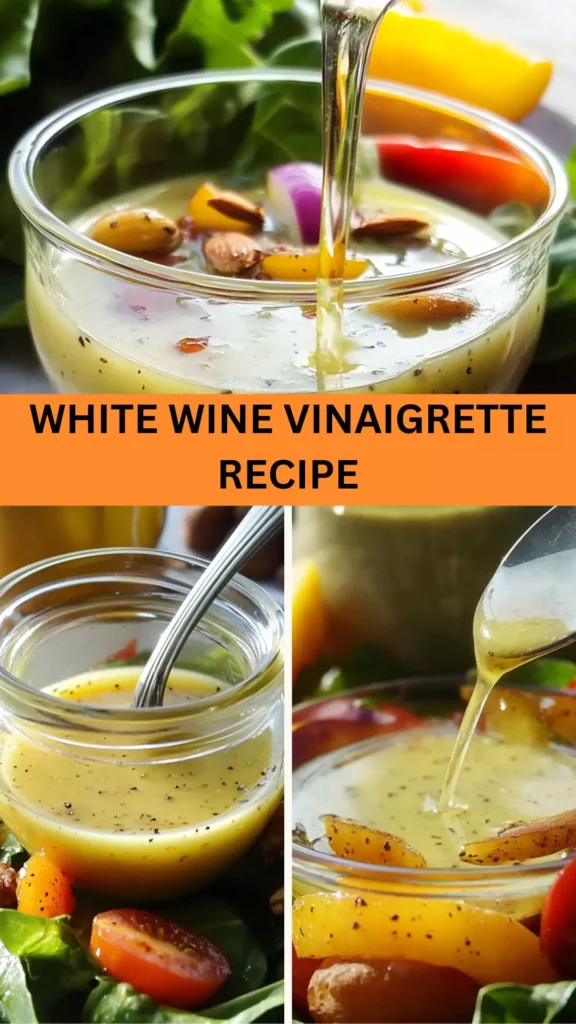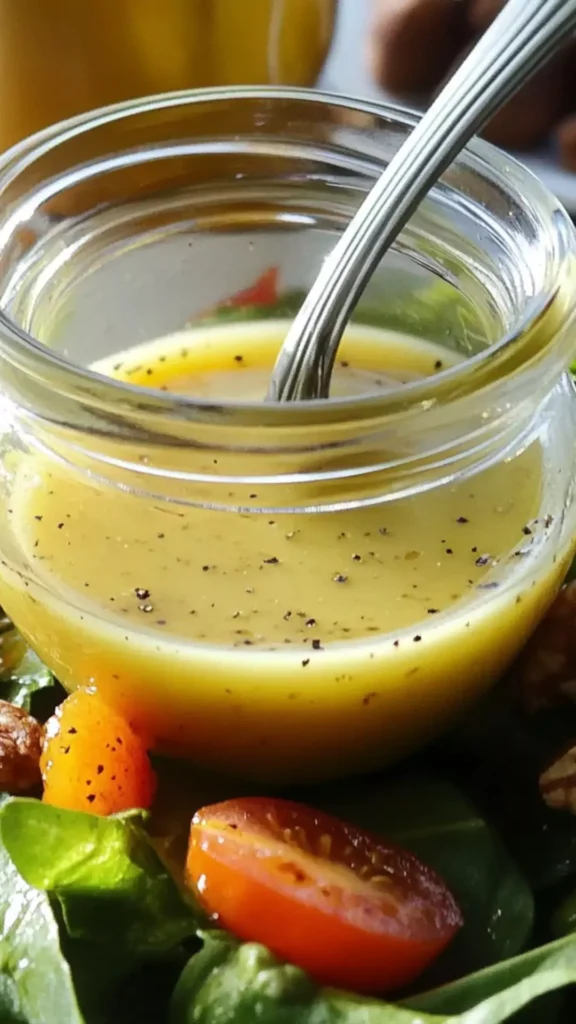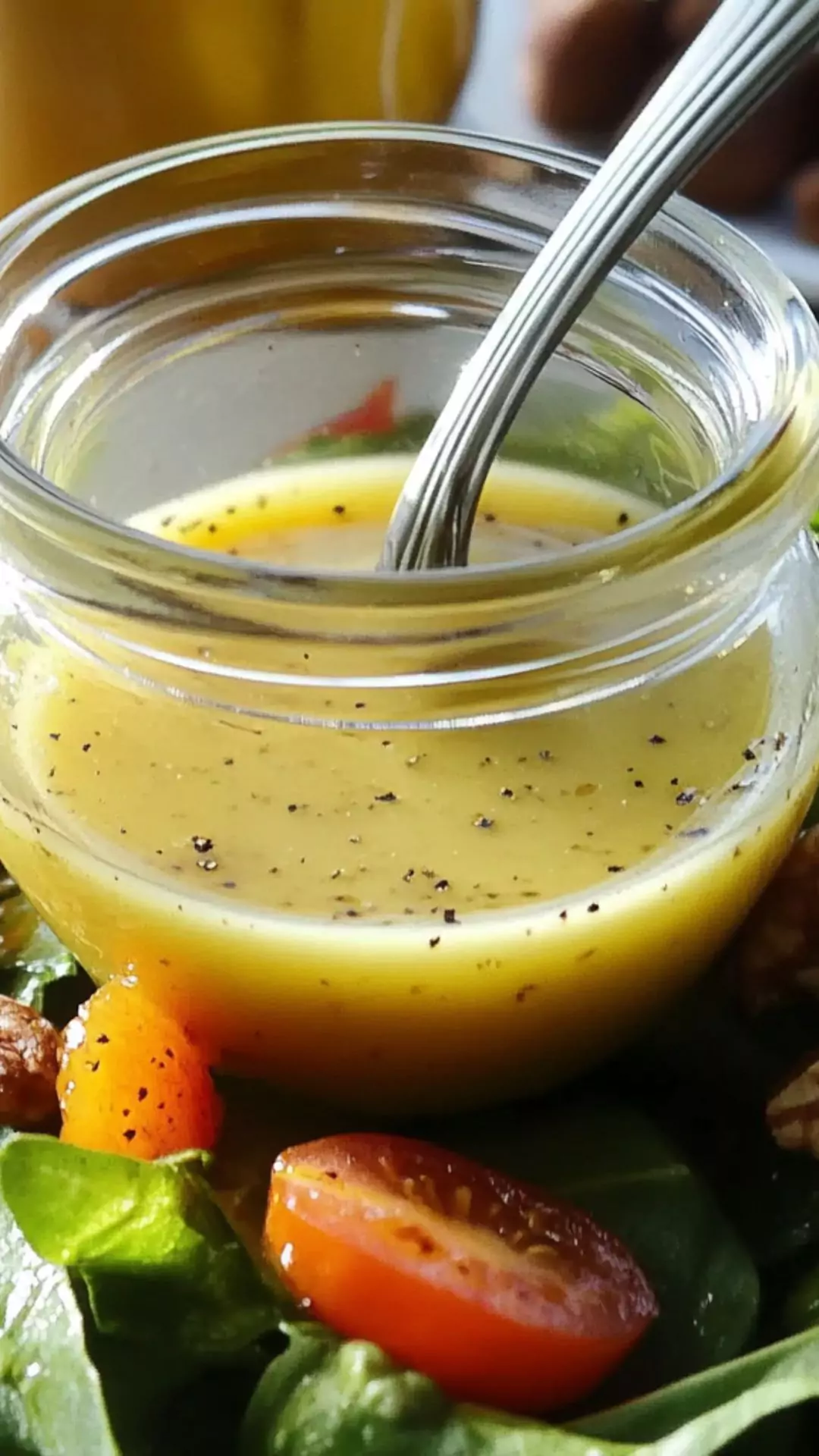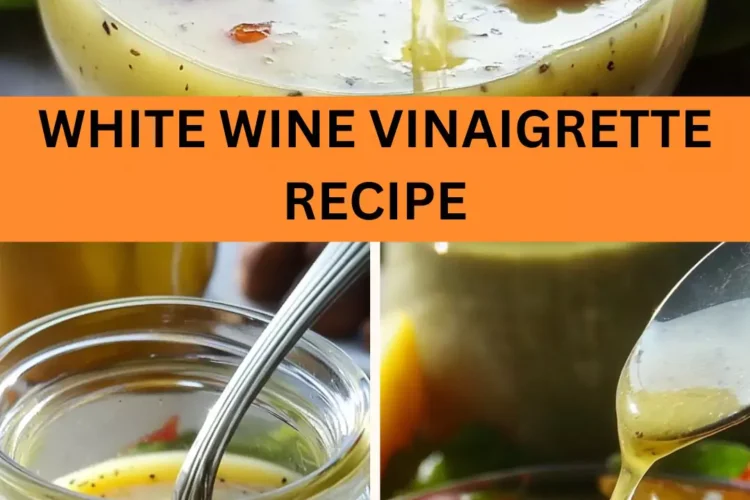When the sun is shining and the grills are fired up, nothing complements a fresh salad quite like a homemade white wine vinaigrette.
Picture this: a big bowl of zesty, colorful pasta salad filled with chickpeas, vibrant bell peppers, and crunchy cucumbers, all drizzled with a tangy white wine dressing. It’s a delightful mix that’s not only refreshing but also brings a zesty punch to any dish.
But what can you pair it with? Grilled Chicken, Roasted Vegetables, Crusty Bread. Now, let’s dig deeper into the deliciousness of white wine vinaigrette.

White wine vinaigrette is not just a dressing; it’s a culinary game-changer. As a registered dietitian and food blogger, I’ve experimented with countless dressings over the years. This vinaigrette stands out for its versatility and balance.
My goal is to share insights that not only highlight how to make this dressing, but also how to appreciate its role in salads, pastas, and even marinades.
By the end of this guide, you will be confident in crafting your own white wine vinaigrette, and it might just become your go-to dressing for summer gatherings or cozy dinners.
You will also like the following Side Dish recipes!
- Best Longhorn Steakhouse Blue Cheese Dressing Recipe
- How to make Original mexican caesar salad dressing
- Easy broccoli salad from chicken salad chick
Why This Recipe Works?
1. Balanced Flavor Profile
This vinaigrette achieves a perfect harmony between acidity and sweetness. The white wine vinegar provides a sharp tang that cuts through rich flavors, while the sugar rounds it out, creating a well-balanced taste that enhances everything it touches.
2. Versatile Use
Whether it’s drizzled over crisp salads, tossed with pasta, or used as a marinade for vegetables and proteins, this vinaigrette adapts beautifully. You can mix it up based on the season or your pantry.
3. Fresh Ingredients
By using simple, fresh ingredients, this recipe encourages you to avoid store-bought options filled with preservatives and artificial flavors. Making your own means fewer additives and more control over the flavor.
4. Quick to Prepare
In just a few minutes, you can whip this dressing up. It’s so easy that you’ll wonder why you ever bought commercial dressings in the first place.
How Does It Taste?
Imagine a bright, tangy flavor dancing on your palate. The first taste is sharp, courtesy of the vinegar, quickly balanced by the sweetness from the sugar, and completed with a warmth from the garlic.
It’s invigorating, refreshing, and beckons for that next bite. Each ingredient plays its part wonderfully, inviting you to savor every morsel.
What Sets This Recipe Apart from Other White Wine Vinaigrette Variations?
One of the features that distinguishes this vinaigrette is its simplicity and accessibility. While many recipes add complex herbs or extravagant ingredients, this one stays true to its roots.
It emphasizes using just a few staple items—like fresh garlic and Dijon mustard— to create a robust flavor.
The Ingredients
Here’s what you’ll need for the perfect white wine vinaigrette:
– 1 tablespoon fresh lemon juice
– 1 teaspoon Dijon mustard
– ⅓ cup canola oil
– ⅓ cup white wine vinegar
– 2 garlic cloves, finely minced
– 1 tablespoon granulated sugar
– ½ teaspoon sea salt
– 1 pinch freshly ground black pepper

Instructions
Step 1: Gather Your Ingredients
Start by assembling all the ingredients on your countertop. Having everything out makes the process smoother. Real simplicity can save you time, and we all love that!
Step 2: Combine the Liquids
In a small mixing bowl, whisk together the white wine vinegar, lemon juice, and Dijon mustard. Make sure they blend well before moving to the next step.
Step 3: Add the Sugar and Salt
Sprinkle in the granulated sugar and sea salt. Whisk again until the sugar is mostly dissolved, creating a uniform mixture.
Step 4: Incorporate the Garlic
Finely mince your garlic cloves and add them to the vinaigrette. This adds a nice depth of flavor.
Step 5: Emulsify with Oil
Slowly pour in the canola oil while whisking continuously. The goal is to emulsify the mixture, meaning you want the oil to combine thoroughly with the other ingredients. This creates a dressing that’s smooth and cohesive.
Step 6: Final Seasoning
Add freshly ground black pepper according to your taste. Whisk it all together one last time. If you need to adjust, feel free to add more salt or sugar to find your perfect balance.
Notes
- Cooking Ahead: This vinaigrette can be made ahead of time and stored in the refrigerator. Just give it a quick shake before using.
- Adjust Sweetness: Depending on your taste, you can tweak the sugar amount. Start small and add until it fits your palate.
- Oil Options: For a different flavor, try using olive oil instead of canola oil. It adds its distinct character to the vinaigrette.
- Garlic Intensity: If you’re not a huge garlic fan, you can reduce the amount or even replace it with shallots for a subtler flavor.
- Herb Influence: Adding fresh herbs like parsley or basil can refresh the dressing further, making it even more delicious.

How Do You Store This White Wine Vinaigrette?
Store your vinaigrette in an airtight container or a jar with a lid. It can last in the fridge for up to two weeks. Just remember to give it a good shake before using it again, as separation is normal.
Sides for White Wine Vinaigrette
When you think of serving this zesty dressing, keep these options in mind.
1. Crunchy Garden Salad: A mix of leafy greens, cucumbers, and radishes. Drizzling this vinaigrette over will brighten every bite. Toss in some sunflower seeds for added crunch.
2. Pasta Salad: Combine cooked pasta, cherry tomatoes, olives, and mozzarella for a delightful side. This vinaigrette acts as the perfect dressing, tying all the ingredients together.
3. Grilled Shrimp Skewers: Brush shrimp with some vinaigrette before grilling. The tangy flavor infuses the shrimp, leading to a mouthwatering dish.
What Alternatives Can You Use for the Ingredients If They Are Not Present in Your Kitchen?
1. Vinegar Options: If you’re out of white wine vinegar, red wine vinegar or apple cider vinegar will work well. Each brings its own flavor twist.
2. Sweetener Substitutes: Honey or agave syrup can replace granulated sugar. It will still create that important balance.
3. Oil Variants: If canola is unavailable, opt for vegetable oil or a light olive oil. Each will do the job of creating that emulsified mixture effectively.
4. Mustard Type: If you don’t have Dijon, any mustard you like (yellow, spicy brown) will work. It might shift the flavor slightly, but it’s still delicious.

White Wine Vinaigrette Recipe
Ingredients
Equipment
Method
- Start by assembling all the ingredients on your countertop. Having everything out makes the process smoother. Real simplicity can save you time, and we all love that!
- In a small mixing bowl, whisk together the white wine vinegar, lemon juice, and Dijon mustard. Make sure they blend well before moving to the next step.
- Sprinkle in the granulated sugar and sea salt. Whisk again until the sugar is mostly dissolved, creating a uniform mixture.
- Finely mince your garlic cloves and add them to the vinaigrette. This adds a nice depth of flavor.
- Slowly pour in the canola oil while whisking continuously. The goal is to emulsify the mixture, meaning you want the oil to combine thoroughly with the other ingredients. This creates a dressing that’s smooth and cohesive.
- Add freshly ground black pepper according to your taste. Whisk it all together one last time. If you need to adjust, feel free to add more salt or sugar to find your perfect balance.
Nutrition
Notes
- Cooking Ahead: This vinaigrette can be made ahead of time and stored in the refrigerator. Just give it a quick shake before using.
- Adjust Sweetness: Depending on your taste, you can tweak the sugar amount. Start small and add until it fits your palate.
- Oil Options: For a different flavor, try using olive oil instead of canola oil. It adds its distinct character to the vinaigrette.
- Garlic Intensity: If you’re not a huge garlic fan, you can reduce the amount or even replace it with shallots for a subtler flavor.
- Herb Influence: Adding fresh herbs like parsley or basil can refresh the dressing further, making it even more delicious.
Tried this recipe?
Let us know how it was!Frequently Asked Questions
1. Can I use this vinaigrette for marinating meats?
Absolutely! This vinaigrette can double as a marinade. It tenderizes meat while infusing it with flavor. Just be sure to marinate for at least 30 minutes.
2. What’s the best way to whip this up for a big gathering?
If you’re preparing this for a crowd, simply triple the recipe and store it in a larger jar. It’s straightforward and will save you time on the day of your event.
3. How can I adjust the flavor if I want it spicier?
You can add a pinch of red pepper flakes or a dash of hot sauce into the vinaigrette. This addition provides a lovely kick.
4. Is this recipe vegan-friendly?
Yes! All ingredients are plant-based, making it a great option for vegan diets.
Conclusion
White wine vinaigrette elevates your culinary endeavors from ordinary to extraordinary. With its balanced flavors and versatility, it’s a dressing that promises to enhance everything from fresh salads to grilled meats. Plus, it’s quick and easy to make!
As you gather around the table this summer, consider whipping up this vinaigrette and drizzling it over your favorite dishes. Your taste buds will thank you, and so will your guests.
Trust me, once you give this vinaigrette a try, you’ll want to make it time and again. So go ahead, get those ingredients together, and let this delightful dressing become a staple in your kitchen!


